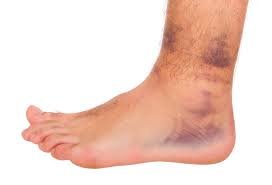Understanding Soft Tissue Injuries: Types, Causes, and Treatment
Soft tissue injuries are a common occurrence in our daily lives. Whether it’s a sprained ankle from a misstep or a strained muscle from overexertion, these injuries can be painful and disruptive. In this article, we will explore the different types of soft tissue injuries, their causes, and the various treatment options available.
Types of Soft Tissue Injuries
Soft tissue injuries can be broadly classified into three categories: sprains, strains, and contusions.
Sprains
A sprain occurs when a ligament, which connects bone to bone, is stretched or torn. This commonly happens in the ankles, wrists, or knees. Sprains are often caused by a sudden twist or impact that forces a joint out of its normal position. Symptoms of a sprain include pain, swelling, and difficulty moving the affected joint.
Strains
A strain, on the other hand, is an injury to a muscle or tendon, which connects muscle to bone. Strains can occur from overuse, improper lifting techniques, or sudden movements that stretch or tear the muscle or tendon. Symptoms of a strain include pain, muscle weakness, and limited range of motion.
Contusions
A contusion, more commonly known as a bruise, is caused by a direct blow to the body that damages the blood vessels beneath the skin. This results in discoloration, swelling, and tenderness. Contusions can occur in any part of the body and are often accompanied by pain and limited mobility.
Causes of Soft Tissue Injuries
Soft tissue injuries can happen to anyone, regardless of age or physical fitness. Some common causes include:
Accidents
Accidents, such as falls, car crashes, or sports-related collisions, can lead to soft tissue injuries. The sudden impact or force on the body can cause sprains, strains, or contusions.
Overuse
Repetitive activities or overuse of a particular muscle or joint can lead to soft tissue injuries. This is common in sports that involve repetitive motions, such as running, tennis, or weightlifting. Overuse can cause inflammation, micro-tears, and eventually, more serious injuries.
Poor Posture and Body Mechanics
Incorrect posture and body mechanics can put excessive strain on certain muscles and joints, leading to soft tissue injuries over time. This is often seen in individuals who have poor sitting or standing habits, as well as those who perform manual labor or repetitive tasks without proper form.
Treatment Options for Soft Tissue Injuries
When it comes to treating soft tissue injuries, the approach depends on the severity and type of injury. Here are some common treatment options:
R.I.C.E Method
The R.I.C.E method is a widely recommended approach for treating soft tissue injuries, especially in the early stages. R.I.C.E stands for Rest, Ice, Compression, and Elevation.
Rest: It’s important to give the injured area time to heal by avoiding activities that may worsen the injury.
Ice: Applying ice to the affected area can help reduce swelling and pain. It’s recommended to apply ice for 15-20 minutes every few hours.
Compression: Using a compression bandage or wrap can help reduce swelling and provide support to the injured area.
Elevation: Elevating the injured area above heart level can help reduce swelling by allowing fluid to drain away from the injury.
Physical Therapy
In more severe cases or for chronic soft tissue injuries, physical therapy may be recommended. A physical therapist can design a personalized exercise program to help strengthen the injured area, improve flexibility, and promote healing.
Medication
In some cases, over-the-counter pain relievers or anti-inflammatory medications may be recommended to manage pain and reduce inflammation. However, it’s important to consult with a healthcare professional before taking any medication.
Bracing or Splinting
For certain soft tissue injuries, such as sprains or strains, a brace or splint may be used to provide support and immobilize the affected area. This can help prevent further damage and promote healing.
Surgery
In rare cases where conservative treatments fail to provide relief, surgery may be considered. This is typically reserved for severe soft tissue injuries, such as complete ligament tears or muscle ruptures.
Preventing Soft Tissue Injuries
While it may not be possible to completely eliminate the risk of soft tissue injuries, there are steps you can take to reduce the likelihood of experiencing one:
Warm-Up and Stretch
Before engaging in any physical activity, it’s important to warm up your muscles and stretch. This helps improve flexibility and prepares your body for the demands of exercise.
Use Proper Technique
Whether you’re lifting weights, playing a sport, or performing any physical activity, using proper technique is crucial. This helps distribute the load evenly and reduces the risk of injury.
Take Breaks and Rest
Listen to your body and take breaks when needed, especially during activities that involve repetitive motions. Resting allows your muscles and joints to recover and reduces the risk of overuse injuries.
Wear Protective Gear
When participating in sports or activities with a higher risk of injury, make sure to wear appropriate protective gear, such as helmets, knee pads, or braces. This can help absorb impact and prevent soft tissue injuries.
Maintain Good Posture
Practicing good posture throughout the day can help reduce strain on your muscles and joints. Whether you’re sitting, standing, or lifting, maintaining proper alignment can prevent unnecessary stress on your soft tissues.
Conclusion
Soft tissue injuries can be painful and disruptive, but with the right treatment and prevention strategies, you can minimize their impact on your daily life. Whether it’s practicing proper technique, using the R.I.C.E method, or seeking professional help, taking care of your soft tissues is essential for maintaining a healthy and active lifestyle.
